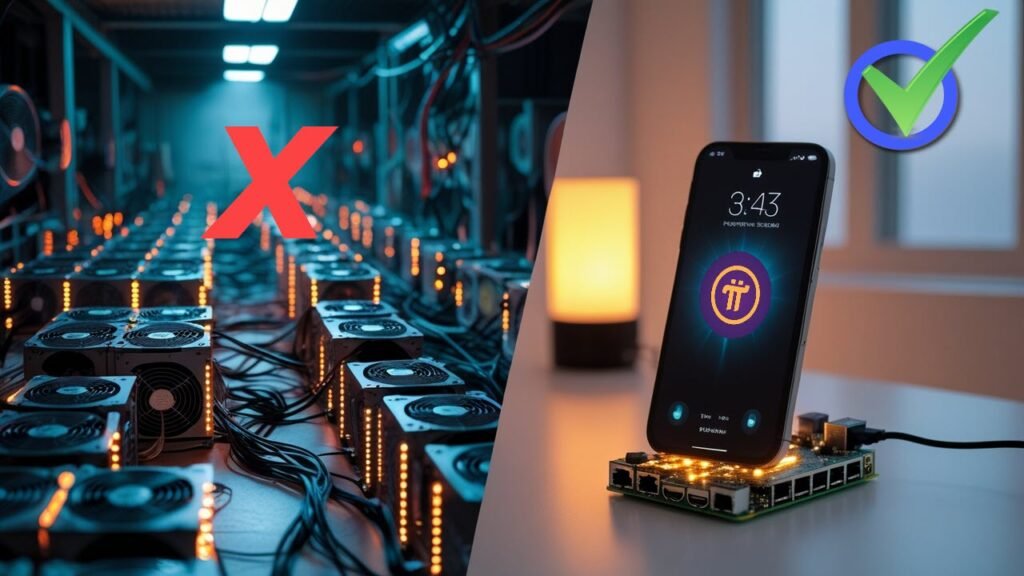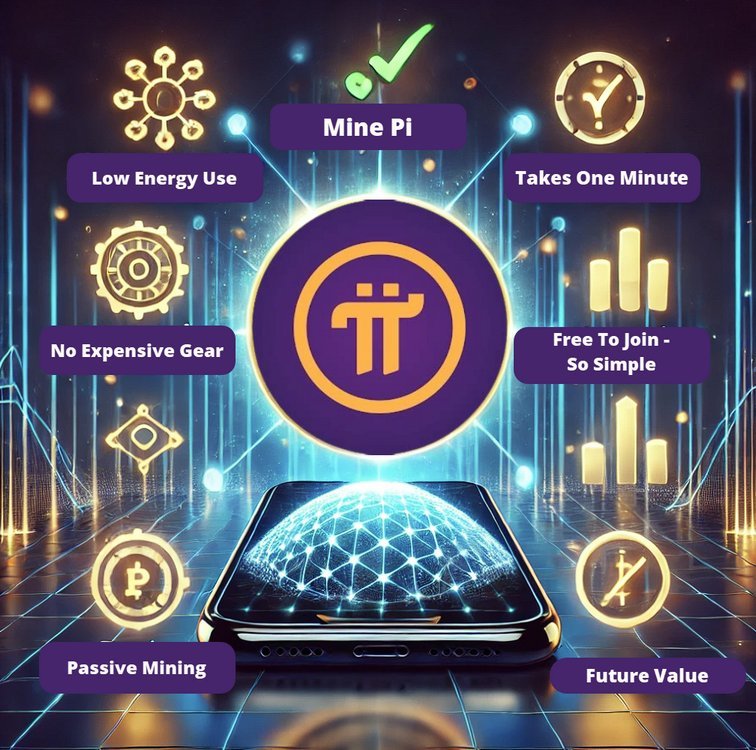Pi Coin Vs Bitcoin: Understanding the Key Differences
Understanding Pi Coin
Trying to understand the pi coin vs bitcoin differences isn’t too difficult. But let’s boil it down and start by focusing first on Pi Coin and the Pi Network.
Pi Coin is a relatively new entrant in the cryptocurrency world. Developed by a group of Stanford graduates, its main goal is to make cryptocurrency mining accessible to the average person. Unlike traditional cryptocurrencies, which require significant computational power to mine, Pi Coin can be mined using a mobile app. This innovation has enabled a larger population to participate in cryptocurrency without the need for expensive mining hardware.
The development team behind Pi Coin seeks to create a peer-to-peer network that is completely decentralized. Through this network, users can conduct transactions while contributing to the security and integrity of the Pi network. Pi Coins are earned by making contributions to this network, which fosters a community-driven ecosystem.
The Fundamentals of Bitcoin
Bitcoin, established in 2009 by an anonymous creator known as Satoshi Nakamoto, was the first cryptocurrency ever. As a pioneer in digital currency, Bitcoin uses a decentralized network where transactions are recorded on a public ledger known as the blockchain. Miners verify transactions by solving complex mathematical puzzles, which in turn ensure the security of the Bitcoin network.
Bitcoin is often viewed as a digital gold standard, given its capped supply of 21 million coins, making it a deflationary asset. The blockchain’s transparency, coupled with its scarcity, makes Bitcoin an attractive choice for investors seeking protection against inflation.

Comparing Mining Processes
One of the stark differences between Pi Coin and Bitcoin lies in their mining processes. Pi Coin aims to democratize mining by allowing users to mine coins through their mobile devices. The light, user-friendly approach of Pi Coin means that anyone with a smartphone can engage with cryptocurrency mining. This has opened avenues for global participation without high energy costs.
In contrast, Bitcoin mining is resource-intensive. Miners require specialized hardware, such as ASICs, and significant amounts of electricity. The complexity of solving cryptographic puzzles increases over time, making it harder for newcomers without powerful equipment.
Pi Coin Mining Features:
- Accessible via mobile app
- No expensive equipment needed
- Community-centric model
Bitcoin Mining Features:
- Requires specialized hardware
- High energy consumption
- Increasing difficulty over time
Network Security
Network security is another area where these two cryptocurrencies differ. Bitcoin’s security is renowned, owing to its proof-of-work mechanism which effectively prevents double-spending and fraudulent activities. This robustness has given it an edge in terms of investor trust and value over the years.
On the other hand, Pi Coin, while innovative, is still in its early stages. Its security is based on a consensus algorithm that requires fewer resources than Bitcoin’s proof-of-work model. While this makes it more accessible, it is yet to be proven whether it will offer the same level of security and trustworthiness as Bitcoin.
Future Prospects
The future prospects for Pi Coin and Bitcoin are shaped by their differing paths and purposes. Bitcoin is seen as a store of value and digital gold, with increasing institutional interest. It is likely to continue dominating the cryptocurrency market as more investors look to hedge against traditional economic fluctuations.
Pi Coin, meanwhile, seeks to broaden accessibility and community involvement in cryptocurrency. Its mobile-based mining could lead to greater mass adoption if the trust and infrastructure improve over time. Its long-term success will largely depend on its ability to build a robust economic model and establish greater security.
Key Takeaways
Pi Coin and Bitcoin represent two distinct approaches to digital currency. Understanding their differences, from mining ease to security, can help potential miners and investors make informed decisions. Bitcoin’s established, secure, and valuable nature continues to attract traditional and new investors. Meanwhile, Pi Coin offers an inclusive platform and democratized approach to cryptocurrency, appealing to those who wish to explore new possibilities in the digital economy.
The Future Potential of Pi Coin in the Cryptocurrency Market
Understanding Pi Coin and Its Unique Attributes
In the rapidly evolving world of cryptocurrencies, Pi Coin offers a fresh perspective, primarily due to its mobile mining capability. Unlike other cryptocurrencies that require significant computational power, Pi Coin allows users to mine directly from their mobile devices. This innovative approach democratizes the mining process, granting more people access without the excessive energy consumption associated with traditional mining operations.

Comparing Pi Coin with Bitcoin
Bitcoin, the pioneering cryptocurrency, is well-known for its decentralized nature and scarcity. Created in 2009, Bitcoin introduced the concept of a blockchain and the proof-of-work consensus mechanism that secures transactions. However, Bitcoin’s mining requires specialized hardware, leading to its centralization in areas with cheaper electricity.
In contrast, Pi Coin leverages a more inclusive approach. Its mobile-friendly mining reduces the entry barriers, allowing a broader audience to participate. While Bitcoin’s value stems from its scarcity and wide acceptance, Pi Coin aims to gain traction through accessibility and community building, potentially opening up a new demographic to the world of digital currencies.
The Role of Community in Cryptocurrency Success
The success of any cryptocurrency often relies on the strength and dedication of its community. Bitcoin boasts a robust network of developers and supporters that contribute to its stability and widespread acceptance. For Pi Coin, fostering a strong community is central to its strategy. By allowing users to mine on mobile devices, Pi Coin promotes engagement and loyalty among its user base.
This grassroots approach to building a network could prove pivotal in establishing Pi Coin’s role in the broader cryptocurrency landscape. As the network grows, so does the potential for partnerships, merchant adoption, and ultimately, the practical use of Pi Coin as a digital currency alternative.

Are There Challenges Ahead Facing Pi Coin?
While Pi Coin presents exciting opportunities, it also could potentially faces challenges. Regulatory scrutiny is becoming more pronounced in the cryptocurrency space. Governments worldwide have been looking to establish frameworks for digital assets. Pi Coin must navigate these regulations carefully to avoid potential roadblocks that could hamper its progress. Everything they have done to this point has been built around sticking to a strict KYC framework for compliance and acceptance. Six years of building and careful planning should see the Pi Network pass any inspection.
Establishing Pi Network’s Real-World Utility
Additionally, establishing real-world utility is crucial. Although Pi Coin’s accessibility is appealing, it must demonstrate tangible value through applications and use cases that transcend mere mining. Partnerships with businesses and other crypto projects could bolster Pi Coin’s relevance in the future digital economy.
Now that we are in the open main net phase, we shall soon see the Ecosystem utilities and services that the core team and pioneers have developed. This is sure to spur even more growth in daily users by providing great value.
Potential for Growth in the Cryptocurrency Market
Cryptocurrency markets are inherently volatile and unpredictable, but Pi Coin’s innovative model offers it a unique opportunity. Its easy-to-use platform appeals to a generation accustomed to conducting most activities via smartphones. Furthermore, the participatory nature of its mining process enhances user engagement and educational opportunities within the crypto space.
- Pi Coin’s accessibility could lead to widespread adoption, particularly in regions lacking expensive mining infrastructure.
- Strong community support might drive circulating supply demand, enhancing market value.
- Partnerships with established organizations could solidify Pi Coin’s credibility.

Looking Ahead
Pi Coin’s prospects will largely depend on its ability to convert early interest into sustained engagement and tangible value. As more users join the network, the following potential economic model and regulatory strategies will determine its place in the crypto market. If successfully executed, Pi Coin’s inclusive approach could position it as a crucial player alongside established cryptocurrencies like Bitcoin.
The cryptocurrency market is ever-changing, and Pi Coin’s future is yet to be written. With the right mix of community engagement, strategic partnerships, and regulatory navigation, Pi Coin could carve out a niche that harmonizes innovative technology with widespread accessibility.
Conclusion
Pi Coin and Bitcoin offer unique features and distinct roles in the cryptocurrency landscape. While Bitcoin stands as the pioneering digital currency, solidifying its place with a proven infrastructure and widespread adoption, Pi Coin emerges with an innovative model aimed at making crypto mining more accessible to everyday users. This stark difference sets the stage for intriguing developments within the crypto arena.
Pi Coin introduces a new approach by leveraging mobile technology. This could democratize access to cryptocurrency by eliminating the necessity for advanced hardware. This could attract a broader audience and foster increased participation in the crypto economy. However, Bitcoin’s status is backed by a robust blockchain, keeping it a leader in terms of market cap and investor trust.
The future potential of Pi Coin hinges on its ability to transition from a novel concept to a tangible asset with real-world applicability. As it continues to develop, its success will largely depend on overcoming scalability and security challenges that come with a burgeoning user base.
Bitcoin, on the other hand, continues to be a benchmark in the space due to its maturity and established trust among investors. Its status as digital gold provides a foundation that newer cryptocurrencies can only aspire to reach.
Ultimately, the comparison between Pi Coin and Bitcoin highlights the dynamic nature of the cryptocurrency market. Pi Coin might appeal to those seeking innovation and inclusivity. Bitcoin remains attractive to those valuing stability and long-term viability. As the crypto world evolves, both coins will likely play critical roles in shaping its future, each catering to different segments of the market and pushing the boundaries of what digital currencies can achieve.









